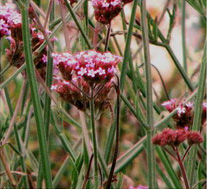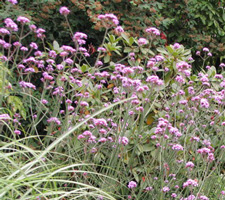Resource Library
Plant of the Week: Verbena, Purpletop
The University of Arkansas System Division of Agriculture does not promote, support or recommend plants featured in "Plant of the Week." Please consult your local Extension office for plants suitable for your region.
Plant of the Week
Purpletop Verbena
Latin: Verbena bonariensis

There are lots of reasons for considering a flower for the garden. Color, form, texture and size are all important but it also has to be easy to grown and likely to survive. A plant that has caught my attention of late which has good marks in all the important categories is a see-through perennial called Purpletop Verbena, Verbena bonariensis.
Purpletop, or as it is sometimes called, "tall verbena" or "Brazilian verbena," is a 3-to 4-foot tall by 2-foot wide verbena that, on first encounter, seems to be all bony legs and elbows. Most of its rather sparse foliage is found at the base of the plant in a tight rosette of leaves with the square, upright stems mostly unencumbered by vegetation.
The upright stems branch freely with a dense cluster of purple or lavender flowers at the terminus of each branch. Individual florets are about the size of a pea but each 2-inch wide inflorescence (a "cyme") usually contains 50 or more blooms. Flowers begin appearing in late spring or early summer and continue until frost. If flowering slows cutting back the plant will encourage a second flush of blooming stems.
Like most verbenas, this species is a short-lived perennial. It is said to be hardy through zone 7 (some say 6), but as is the case with most verbenas, it is intolerant of cold, wet soil, so tends to survive as a self-seeding annual in the northern part of its hardiness range.
This species is native to Brazil and Argentina and was described by Linnaeus in 1761, so it has been known for a long time. Bailey does not mention it in 1917, but Everett describes it as having already naturalized in the South by 1964. Likely it was introduced into U.S. gardens early on and has escaped from these gardens like several other South American annuals that form the basis for the modern bedding plant industry. Plants such as petunias, portulaca, salvia, lantana and several related species of verbena can be found here and there in naturalized stands across the South.

Purpletop has escaped cultivation in zones 9 and 10 but even in that mild region doesn’t seem to have become widespread. Distribution maps show it scattered here and there in southern states. Though several states list it as an escaped weed it doesn’t rise to the level of concern caused by more aggressive plants that tend to out-compete native forbs and grasses.
In the garden, purpletop has enjoyed considerable popularity in recent years as an airy filler and weaving plant to tie together perennial borders. It is ideal for adding summer color to otherwise bland spaces such as beds containing spring blooming bulbs or iris plantings.
Purpletop is open and airy enough with flowers of just the right shade and hue of purple to take on chameleon-like characteristics and blend with almost everything. The open characteristic of the plant also makes it a good companion because the other plants in the bed get all the light and room they need to flourish.
Purpletop is available in the perennial plant trade in various sized pots or sometimes is offered as an annual in bedding plant trays. Or, if you have a friend with a plant, you can grow your own from seed. Seed should be planted in the late fall, scattering the tiny seeds directly on the soil surface where you wish it to grow. Pot grown perennials, except in the milder parts of the country, are best planted in the spring. It is extensively used as a summer filler in many Canadian gardens.
This verbena is not particular about soil type but will be short lived in areas with winter-wet soil. It is best in full sun or very light shade. Pinching the plants in early spring as the shoots begin to elongate will increase the fullness of the plant and keep the height at a more manageable level.
By: Gerald Klingaman, retired
Extension Horticulturist - Ornamentals
Extension News - August 31, 2007
The University of Arkansas System Division of Agriculture does not maintain lists of retail outlets where these plants can be purchased. Please check your local nursery or other retail outlets to ask about the availability of these plants for your growing area.